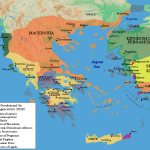In ancient Greece, the main type of beard was a lush full beard. In Sparta, this is a complicated issue. Spartans are generally said to have had beards without mustaches. However, every depiction in art does not support this except in figurines where the beard is carved and the mustache is not.
However, as shown by examples of finds, such as the Etruscan Sarcophagus of the Spouses currently in the Louvre, the mustache could have been added to the polychrome. The fact that the paint is not preserved, would explain the lack of mustaches on the figures1. In addition, as reported by Plutarch, those from the group of Spartan hoplites who turned out to be cowards in a dangerous situation, e.g. half of the beard was shaved. And this proves that the Spartans had to wear mustaches2.
It seems that it was Alexander the Great who started the fashion for full-face shaving among soldiers. Plutarch reports that Alexander ordered his generals to shave because in battle an enemy could pull their beards and thus easily defeat3. Interestingly, the rulers of the Hellenistic states after Alexander are mostly shaven, but there are some bearded rulers like Philip V.
Romans at first wore full beards, but probably influenced by Greek fashion, the Roman elite in the 2nd century BCE started shaving their mustache4. Although, as in the case of the Spartans, the surviving works of art do not confirm this, and it seems to me that it is not true.
The fashion for shaving facial hair among Roman elites came at the end of the republic. As we can read in Garrett Ryan’s book:
The great warrior Scipio Aemilianus, the conqueror of Carthage, is remembered as the first Roman to shave daily, and all significant figures of the late Republic and early Empire followed his example5.
– G. Ryan, Naked statues, bellied gladiators and war elephants, Poznań 2023, p. 19
Emperor Hadrian, who probably wore a beard to cover acne marks, started the fashion for beards among the Roman emperors. This situation lasted until the rule of Constantine I the Great. However, after him some emperors wore beards. Not only Julian the Apostate, who was a pagan and wore a full beard in the old Greek pattern but also m. Maximin Daia, Vetranio and Flavius Eugenius.
The shaving itself was not the most pleasant. Razors were made of iron or bronze. Due to the rapid blunting of razors, they tore the skin and led to its considerable injury. Another method of getting rid of hair was to burn it with heated walnut shells. Yet another solution was to use resin.







